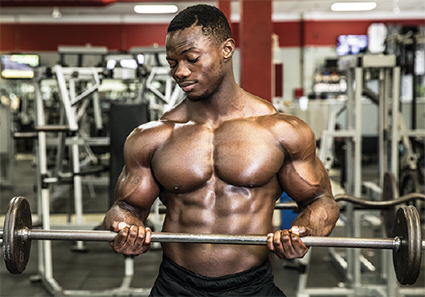6 Rules of Muscle Growth

How good is your approach to training? Let’s just say that if you veer away from these key concepts, you’ll make your journey all the more challenging.
There are rules that govern every sport. Score a touchdown and your team is awarded six points with an opportunity to go for more. Hit a jump shot and you get three points—but the arc is longer in professional basketball than in college. In hockey, you can’t be ahead of the blue line without the puck when your team has possession.
In bodybuilding, there are no such rules and regulations. You’re free to build muscle making any decision you want regarding your training and nutrition, which can result in spectacular muscle growth—or hardly any at all. To help put you into the former category, here’s a list of the six key rules you should never break when it comes to your training and nutrition. Since you won’t see them posted on the mirror next to the sign to return your weights—and they’re much more important to your eventual success—we’ll instead post them here.
1. Never venture away from basic movements.

By now, hopefully you’ve learned the fundamental movements and movement patterns essential to building a strong, functional physique without any weak links. As a beginner, you learned foundation exercises that taught your body how to complete fundamental movement patterns. Although experience teaches you new and different variations of those exercises, and new angles from which to attack a target body part, as a rule those same exercises are now and tomorrow the same ones you’ll be using over the course of your bodybuilding career. (If you avoid them, we’ve really got a problem.)
The best mass-building moves, the ones that initiate the most favourable anabolic hormone response, are multi-joint exercises. Why? Because they allow you to push the heaviest loads, requiring two or more sets of joints to work in tandem to create the lift. On the list: bench presses, squats, deadlifts, overhead presses, rows, bent-over rows, and the like. Always make those the foundation of your workout, and do them early in your training session with challenging loads before fatigue sets in.
2. Never think just any old approach will optimize muscle building.

You can do just about any old gym workout and somethingwill happen, but the question is whether you fast-tracked strength and size gains or whether you wasted a lot of effort. Despite the best of intentions, all too many beginners simply lack the education to know the most important principles of growth. Doing multi-joint movements is the single most-important variable for growth, but it’s not the only one. Here’s what we know about optimizinghypertrophy.
Intensity. Most of us wronglythink a hard, exhausting workout is an intense one, but that’s not how intensity is defined by exercise scientists, and it’s an important distinction. Instead, intensity is a relationship expressed as a percentage of the weight you use on a given exercise compared to your one-rep max for that movement. So if you do 225 pounds on the bench press and your max is 275, divide 225 by 275 and you get roughly 82 percent.
Exercise scientists have determined that training within 70 percent to 85 percent of your one-rep max is the mostfavourable for building muscle. That corresponds to numbers you may be more familiar with: taking a set to muscle failure between 6 and 12 reps. So if your 1RM for the bench is 275, the lower end of your working weight (at least for optimizing muscle growth) is 70 percent of 275, and the upper end is 85 percent of your 1RM. That equates to using a load between 190 and 235 pounds. Using a weight outsidethese boundaries, then, sacrifices some degree of muscle growth (at least for most people).
It should be noted that strength training is optimizedwhen using loads of fewer than 6 reps, which means using loads greater than 85 percent of your 1RM. You can do your own math to compute the working weight (hint: after warm-ups it’s with 235 or more pounds on the bar, which is at least 85 percent of your 1RM).
Remember that each exercise has its own 1RM, that doing a movement later in your workout when fatigue sets in affects your 1RM, and that your 1RM changes over time.
Volume. This is a measurement of how much work you do for a body part, determined by multiplying how many sets you do for a muscle group by the number of reps and the load. Multiple-set protocols consistently have been shown to be superior to single sets when it comes to building muscle, but there is certainly a point of diminishing returns: You can easily do too muchwork. Although more advanced training programs allow for greater volume, which creates greater muscle damage, this should be offset by a reduced training frequency for that body part.
Training to Failure. This is an important concept in bodybuilding: going to the point in which you can’t do another rep with good form, which also creates a more favourable anabolic stimulus. You should never stop a set because you arbitrarily reached a target rep; end it when you can’t do another rep while maintaining good form. If you can do more than about 12, adjust the weight on your next set as necessary. Likewise, if you can’t do at least 6, you’ll want to lighten the load, especially in the context of building max muscle. What’s more, because doing too many sets past failure using advanced training techniques has been shown to be counterproductive in research, save them for your heaviest sets or final set of an exercise.
Rest Intervals. It’s hard to imagine that what you’re notdoing between sets affects hypertrophy, but it indeed does. That’s because in bodybuilding training, you wantfatigue to accumulate over the course of your workout. Too-long rest periods allow for too much recovery (unless you’re training for strength) and too-short ones adversely affect the following set. Restrict rest periods to 60 to 90 seconds to maximize the hypertrophic response.
3. Never train pedal-to the-metal exclusively.

In a sport in which pushing to utter exhaustion in the gym seems to be the measure by which those who succeed in bodybuilding differ from those who don’t, doing more will always be appealing. More exercises, more sets, more advanced training techniques, more time in the gym, etc. But as we already noted above, pushing past failure too often can result in suboptimal gains.
Although stimulating anabolism is essential, there’s a fine but indistinguishable line you cross when you’ve done too much. Here, another hormone begins to make an appearance: cortisol. For bodybuilding purposes, cortisol works in opposition to anabolic hormones such as testosterone and growth hormone, tearing down muscle tissue. And it’s bad for your health when it’s elevated long term, as well.
Although it’s tempting to want to do extra work in the gym in your pursuit of building max muscle, it’s important to restrict the total number of sets you do for a given body part and the length of your workout. Unfortunately, there isn’t a magic number to give you because so many different factors are at play: your age, training experience, sets to and beyond muscle failure, sleep, diet, genetics, even what you do outside the gym. That’s why you’ll often see a suggested max for the number of sets you should do for small and large body parts. Remember, you’ll never make up for a lack of training hard by extending your workout and doing more sets—that’s not how it works.
Besides overtraining, going full bore all the time can adversely affect your joints and nervous system. Injuries flare up and you need to learn how to back off. Rest days help restore not just the glycogen in your muscle cells and central nervous system fatigue but also your mental approach to avoid burnout. A stagnated workout doesn’t necessarily mean it’s time to do more: Sometimes it’s a sign to do less.
Learn about the importance of active rest, and why taking time off for a vacation may be a better alternative than never missing a workout. Sure, it takes a somewhat obsessive mind-set to succeed in bodybuilding, but you’ll be better in the long run, especially as you age, if you’re able to find a good balance.
4. Never get overly comfortable with your routine.

It’s critical to understand that adaptation drives your muscle fibres to grow bigger and stronger when confronted with a training stimulus. (Early on, many of those changes are the result of neurological adaptations—the muscles simply learn to fire together more efficiently—but soon thereafter, actual changes in the muscle fibres begin to occur.) But as you start making gains, measured by an uptick in strength or your ability to do more reps with a given weight, you must continue to increase the overload to keep making further gains. That is, your body needs an increased degree of stimulus because it’s already adapted to the one you’ve placed upon it. If you fail to increase the stimulus, you’ve given the muscle fibres no reason to grow further.
That’s why it’s called progressiveoverload, which simply means you continue to challenge your body to new levels of performance as it adapts to previous marks you set before it. If you’re putting your training on autopilot and have grown comfortable with your routine, chances are it stopped working long ago.
It’s important to understand the role of making changes in your training from all the variables listed in the first item to prevent complete adaptation. Suffice it to say that if you’re still following the same routine you have for months—or worse, years—you’re likely seeing few changes in your physique, if any.
5. Never put fewer than 30 to 35 grams of protein on your plate.

How do bodybuilders eat differently from most North Americans? The lifter starts with his protein source and amount, including its preparation method, whereas most folks simply ask, “What do I feel like eating?”
Eating like a bodybuilder doesn’t come naturally for some, especially when you’re bombarded with messages for all the wrong kinds of tasty foods in supersized portions. It’s more than easy, in fact, to get a day’s worth of saturated fat in a single meal, especially if you’re not reading food labels.
One place to start is with your protein source and making sure it includes about 30 to 35 grams, and knowing if two chicken legs are enough, or should you go instead for the full breast. Learning how to eyeball portion sizes is helpful in the kitchen, as is knowing how many grams of protein are in a 4-ounce serving off the restaurant menu, or if you need a double order instead.
That’s just a first step in understanding bodybuilding nutrition. Knowing the role of carbohydrates and fats also helps you make better dining decision. What’s more, spreading the food across five or more meals keeps muscle protein synthesis elevated for longer than if you consumed just three.
Supplements help fill in the blanks, providing raw materials that may be lacking in your diet. For most of us, eating five or six whole-food meals daily just isn’t practical, but downing a shake at work or in between classes is much more convenient. The science of supplementation has indeed come so far that any number of performance-enhancing options are available depending on your personal goal.
6. Never think you’ll achieve success overnight.

A journey of a thousand miles begins with a single step. Although I’m not a fan of writing clichés, in bodybuilding, it’s essential to take the long view. There’s no reaching your goals overnight, and depressingly few shortcuts. Each workout gets you one step closer to your goal; each missed workout, one step back.
The men and women whose fan pages you subscribe to on social media have put in yearsof training. Gains from week to week are hardly noticeable; in fact, some years you may gain only 10 pounds of muscle. But like compounding interest in a bank, after years the gains appear much more sizeable. That’s why it’s so important to take a longer view and learn to enjoy the process: the challenge in the gym and the great feeling a hard workout gives you. Along the way, you’ll hit setbacks such as injuries and training plateaus, and how you respond to each will likely determine whether or not you continue your path forward.
Assuming you enjoy the challenge of lifting, dedication and persistence are key for long-term success. Rome wasn’t built in a day, and neither will your physique.

